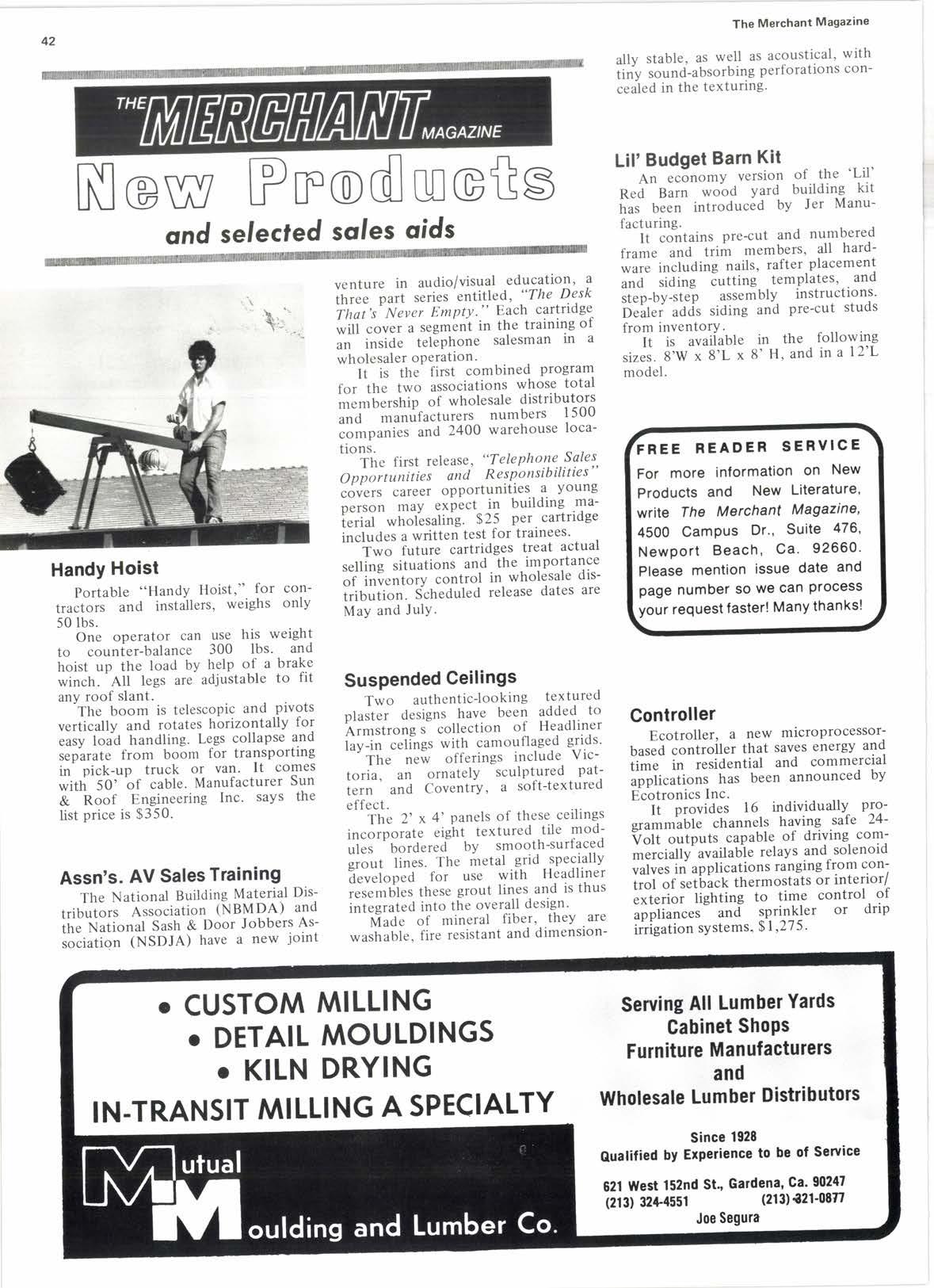
3 minute read
WWPA stages a biggie
A necOnO registration of nearly tal100 attested to the confidence felt by members as they gathered in San Francisco for that industry ritual, the spring meeting of the Western Wood Products Association.
Several hundred additional, unregistered conventioneers added to the considerable jam in the lobby of the St. Francis Hotel that always marks the event. One expensively dressed San Francisco dowager was overheard re-
R0ttS R0YCE door is being opened in (1) by Don Crane, who hired the big black limo as a surprise taxi to take his PSF, Inc. and Feather River Moulding Co. troops out to dinner. Now that's fint class! (2) Front Row: Ted Heweitt, Roger Baer, Nancy Johnson, Mike Singleton. Back Row: Rose' mary and John Wetsel. (3) Tenas DeJong, Pat Patrick, Vic Czarnowsky, Scott Cardwell. (4) Bill Hendricks, Ernie Stovall, Ed- win G. Lammei(5! Joseph H. Habgood, Don Shum. (61 Buss Fredsall, Walt Black, E. M. Stoddard. Ralph Summy. (71 Bill Nathews, Paul Smith. (8) Gordon King, D. R. Petenon, G. E. Franklin, E. C. Muller. (9) Pete Kepon,William Hill,Stanley Hulettt. (10) Maureen Hill, Bob Shannon, Bill Carter. (11) Paul Ward,0ddie Dalen, Bill Niesen, Steve Morgan. (12) Bill Kirktland, Greg Franklin, Pat Byan. marking to a friend, "What are all these people doing in here?" as she slowly made her way through thickets of conversing lumbermen.
Good tidings were presented by George A. Christie, considered by many to be the "dean" of housing forecasters, as he put forth his view that basic demand for housing for the next five years should run at 1.91.95 million starts annually, supported in great measure by demographics: a large number of people at the house buying age.
Like others, he sees a second half decline, to a final housing rate of approximately 1.850 million starts this year. He sees the market coming back from that "plateau" and moving up to a good 1980.
In a Q&A session, Dr. Christie said he sees "no general scarcity of capital developing over the next five years;" less violent housing cycles;and federal sewage and water programs freeing up new land for housing development.
Econonrist and former price controls adminstrator C. Jackson Gravson. speaking on productivity, opened his talk by noting that price controls "never did and never would work." With inflation "embedded" in our economy at 6Vo - 6/z% now, moving perhaps to 7% this year and 8% in 1979, Grayson feels productivity is the best way to counter inflation's effects.
WWPA demonstrated new lumber testing apparatus (see photos) that is part of the National Lumber Testing Program, the most far reaching such program ever attempted.
A cooperative industry undertaking, it is being backed and operated by various associations, the Forest Products Lab of Madison, Wi., and several universities. Its objective is to better understand lumber's strengths and weaknesses so that its engineering capabilities can be better appreciated.
It will be remembered that last year some adjustments in the tension values of lumber had to be made as it was found that certain lumber was not as strong as originally believed. This was confined to lumber's uses in truss manufacturing, and then only in the wider widths and lower srades.
Story at a Glance
Optimisim and a record registration at WWPA semi-annual meeting new lumber testing program unveiled .. . RR car shortage problem hit . . A.M. Whiting re-elected president.
The present program is envisioned to last up to four years.
In a major address, A. M. "Mickey" Whiting, WWPA president, bluntly warned that "new houses in America may be a thing of the past" if the current Forest Service studies of roadless areas for wilderness review (RARE II) are not brought to a fair and prompt conclusion. The resulting artificial timber shortage could go on indefinitely, he said.
Whiting said the RARE II-based shortages will develop in everything from new homes to recteation areas for the majority of the public.
The study commenced last year in a Forest Service effort to meet environ- mentalist obiections to an even earlier review, (RARFI'I). The earlier study a.lso had been forced by environmentalist action even though the present National Wilderness Preservation System is greater in area today than was intended when the Wilderness Act was passed in 1964.
RARE II has placed more than 66 million acres "in suspense" in the U.S. as far as further development goes. Most of those acres lie in the West, and many of the lumbermen attending the WWPA meeting are directly affected.
"In the end," Whiting said, "RARE (Please turn to page 26)
HUGE TUBN0UT included (1) Sterling Wolfe, Roger Burch, Mike Roach. (2) Rick Rosa, Bob Riggs, Dave Snodgrass, Al Caldwell (3) Betty Foster, Bill Bright, Jack Powell. (4) Ron Lewman. Jim Frodsham. (5) John Gaskin, Mike Parli, Mark Lofland. (6) Pete and Susan Parrella, "Mac" Mclnelly. (7) Rosie Gilbert, Jerry Floth, Ted Gilbert. (8) Johnny Cummins, Wayne Murphy, Bob Golding. (9) Pete Middlekauff, Roy Gilmore, Mike Edgar. (10) Paul Herrfeldt, Cliff Smoot, Joe Bowman. (11) Tom Lannin, Jim Rossman, Bill Bonnell. (12) Carol Rourke, Jim Fraser.











